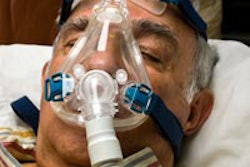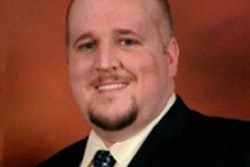
Not only can it run you off the road, it can kill you in your sleep.
Obstructive sleep apnea (OSA) -- a potentially dangerous sleep-related breathing disorder -- affects more than 18 million Americans per year, kills 38,000, and is undiagnosed in 80% to 90% of people who suffer from it, according to the American Academy of Sleep Medicine.
Now dentists are being urged to play a more central role in screening patients for OSA and related sleep disorders and to work in tandem with physicians to help in treating these patients as well. Because patients see dentists on a more regular basis than they see physicians, dentists can notice early warning signs of sleep disorders, then cotreat with the patient's physician.
“Dentists need to screen for sleep-related breathing disorders as part of routine workups.”
— Michael Simmons, D.M.D., University
of California, Los Angeles
"Physicians don't always look at the patient's throat, but dentists have to look in the patient's mouth," said Mansoor Madani, D.M.D., M.D., an associate professor of oral and maxillofacial surgery at Temple University. "They may save the patient's life by doing that simple exam, just like they do every single day with oral cancer screening."
Unfortunately, the majority of U.S. dental schools do not adequately prepare their graduates to screen for sleep disorders, according to a study presented June 5 at the American Academy of Dental Sleep Medicine (AADSM) annual meeting. Researchers from the University of California, Los Angeles (UCLA) School of Dentistry surveyed each of the 58 U.S. dental schools to determine the average number of curriculum hours offered in dental sleep medicine.
Forty-eight schools responded to the survey and indicated that dental students spend an average of 2.9 instruction hours during their four years of dental school studying sleep disorders.
According to lead author Michael Simmons, D.M.D., part-time instructor at UCLA, sleep medicine is being introduced at the majority of U.S. dental schools, but the total hours taught are inadequate given the epidemic proportion of people with OSA.
"Dental students and dentists need to screen for sleep-related breathing disorders as part of patients' routine workups," Dr. Simmons said. Then, with additional interest and adequate training, they can learn to cotreat these serious medical conditions with their patients' physicians as an integral part of the sleep medicine team."
What is OSA?
The American Academy of Dental Sleep Medicine estimates that about half of people who snore loudly have OSA. It is not the only sleep-related breathing disorder -- others include upper airway resistance syndrome (UARS) and even simple snoring -- but it is potentially more dangerous. With UARS and snoring, the airway is constricted, but in OSA a portion of the upper airway partially or completely collapses or becomes blocked, often hundreds of times per night.
In fact, a person with OSA may stop breathing for 10 to 30 seconds or even longer, leading to serious drops in the oxygen level in the blood and eventually waking the person to breathe. To the spouse or bed partner, this can sound like snoring, followed by 10 or more seconds of silence, then snorting, choking, or gasping for breath (Oral and Maxillofacial Surgery Clinics of North America, November 2009, Vol. 21: 4, pp. 369-375).
In the short term, this disturbed sleep leads to another key symptom of OSA: excessive daytime sleepiness. The National Sleep Foundation's 2009 Sleep in America poll found that 1% of drivers had a crash or near miss due to sleepiness within the last year, with 28% of American drivers driving drowsy at least once a month. According to the AADSM's Dentists Against Drowsy Driving Web page, excessive daytime sleepiness is believed to contribute to $48 billion in healthcare costs related to drowsy driving accidents per year.
In the long term, OSA's constant stress on the body is believed to contribute significantly to various conditions. The AADSM notes on its website that OSA increases a patient's risk for diabetes, obesity, and depression. It has also been shown in multiple studies to cause a range of health effects, including memory problems, headaches, decreased libido, hypertension, stroke, heart attack, and sudden death during sleep.
"If someone has a pre-existing heart disorder, and they are not breathing properly, they are more predisposed to heart attack or stroke because of that lack of oxygen," Dr. Madani said. "In the past, physicians noticed that people would just die in their sleep. Now we know that they are related. Not enough oxygen is reaching the brain or the heart, and that is the main cause of heart attack and stroke."
OSA predictors
The greatest predictors of OSA are neck size larger than 16.5 inches, obesity (with 85% prevalence in those with a body mass index higher than 30), and structural problems such as an enlarged tongue, tonsils, or uvula or receded jaw. Previous statistics placed the male to female prevalence at 2:1, but current research places the ratio as high as 9:1, according to Dr. Madani.
 In obstructive sleep apnea, the upper airway is completely or partially blocked, often hundreds of times every night. This can lead to serious medical complications, increased risk of daytime car and work accidents, and even sudden death during sleep. Image courtesy of Mansoor Madani, D.M.D., M.D.
In obstructive sleep apnea, the upper airway is completely or partially blocked, often hundreds of times every night. This can lead to serious medical complications, increased risk of daytime car and work accidents, and even sudden death during sleep. Image courtesy of Mansoor Madani, D.M.D., M.D.
"Men are more affected because of their neck size and the way that their bodies are structured," he said.
A fourth of all OSA patients have a genetic predisposition due to the inherited shapes of their skulls and noses or soft-tissue structures such as the palate, uvula, and tongue. Certain genetic diseases such as Down syndrome are also a risk factor, as are alcohol and tobacco use and inadequately treated seasonal allergies.
Less attention has been given to children at risk for sleep-related breathing disorders, although this appears to be changing. Results from a study conducted at the University of North Carolina and presented at the AADSM annual meeting in San Antonio found that 18% of pediatric patients were at risk for the disorders, and screening tools such as the Pediatric Sleep Questionnaire offer dentists an opportunity to recognize, educate, and refer pediatric patients that may be at risk for sleep-related breathing disorders.
And a recent British Medical Journal study found that OSA untreated in children often leads to neurobehavioral problems resulting from the sleep fragmentation and hypoxia (May 8, 2010, Vol. 340:7754, pp. 1018-1023). The authors suggest that for children an adenotonsillectomy will often resolve sleep apnea, particularly if there is evidence of large tonsils and adenoids but no other underlying medical condition.
When it comes to determining whether children have sleep apnea, it's important to find out if they are getting ample sleep appropriate to their age, according to Ron Attanasio, D.D.S., MS.Ed., M.S., director of the TMD and Orofacial Pain Clinic at the University of Nebraska and co-author of Dental Management of Sleep Disorders. If that has been addressed, then it may be something anatomical such as large tonsils and adenoids or a growth discrepancy with the maxilla or mandible. Children may need an orthodontic evaluation, and they should also have allergies ruled out.
To incorporate OSA screening into your daily practice, Dr. Madani advises dentists to spend less than 2 minutes looking at the patient's neck size, body weight, airway, tonsils, and uvula. If OSA is suspected, the patient should be referred to a sleep physician to undergo a polysomnogram for a final diagnosis.
Part 2 of this two-part series will look at multiple treatment options for obstructive sleep apnea and other sleep-related breathing disorders.
Copyright © 2010 DrBicuspid.com



















